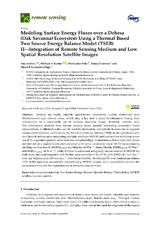Modeling Surface Energy Fluxes over a Dehesa (Oak Savanna) Ecosystem Using a Thermal Based Two Source Energy Balance Model (TSEB) II—Integration of Remote Sensing Medium and Low Spatial Resolution Satellite Images
Autor
Andreu, Ana
Kustas, William P.
Polo Gómez, María José
Carrara, Arnaud
González-Dugo, Maria P.
Editor
MDPIFecha
2018Materia
EvapotranspirationTwo Source Energy Balance
Spanish dehesa
Thermal data
MODIS satellite
Landsat satellite
METS:
Mostrar el registro METSPREMIS:
Mostrar el registro PREMISMetadatos
Mostrar el registro completo del ítemResumen
Dehesas are highly valuable agro-forestry ecosystems, widely distributed over
Mediterranean-type climate areas, which play a key role in rural development, basing their
productivity on a sustainable use of multiple resources (crops, livestock, wildlife, etc.).
The information derived from remote sensing based models addressing ecosystem water
consumption, at different scales, can be used by institutions and private landowners to support
management decisions. In this study, the Two-Source Energy Balance (TSEB) model is analyzed over
two Spanish dehesa areas integrating multiple satellites (MODIS and Landsat) for estimating water
use (ET), vegetation ground cover, leaf area and phenology. Instantaneous latent heat (LE) values
are derived on a regional scale and compared with eddy covariance tower (ECT) measurements,
yielding accurate results (RMSDMODIS Las Majadas 44 Wm-2, Santa Clotilde RMSDMODIS 47 Wm-2
and RMSDLandsat 64 Wm-2). Daily ET(mm) is estimated using daily return interval of MODIS for
both study sites and compared with the flux measurements of the ECTs, with RMSD of 1 mm day-1
over Las Majadas and 0.99 mm day-1 over Santa Clotilde. Distributed ET over Andalusian dehesa
(15% of the region) is successfully mapped using MODIS images, as an approach to monitor the
ecosystem status and the vegetation water stress on a regular basis.

